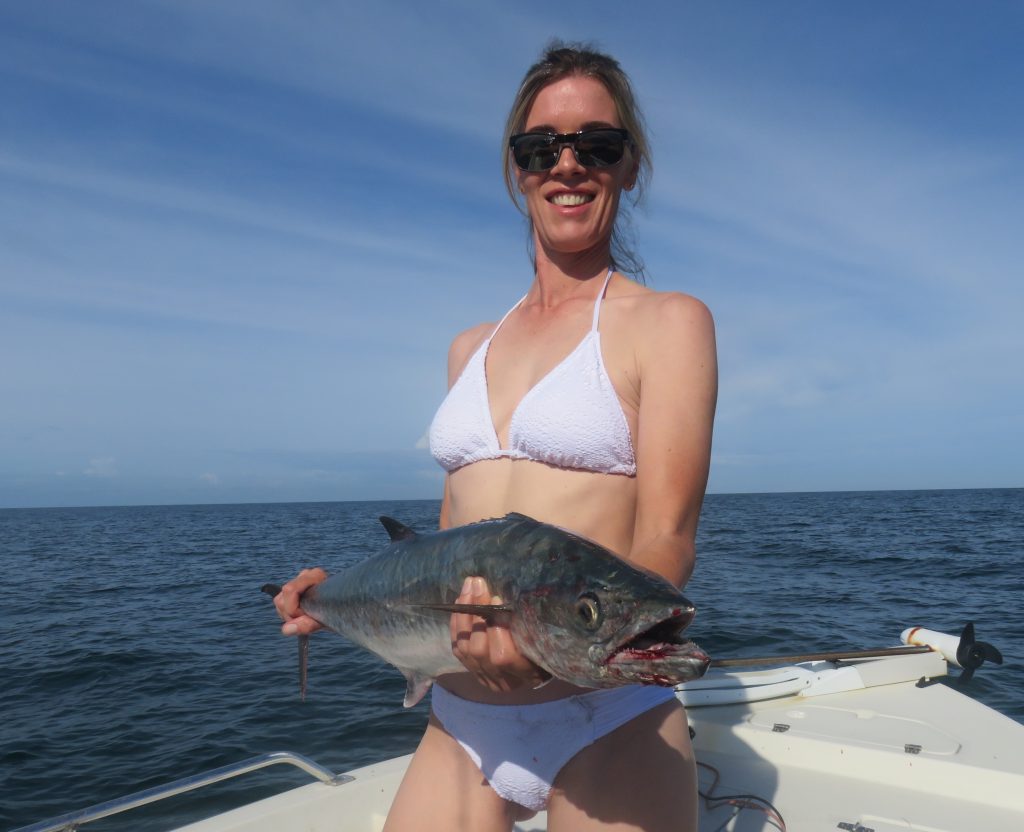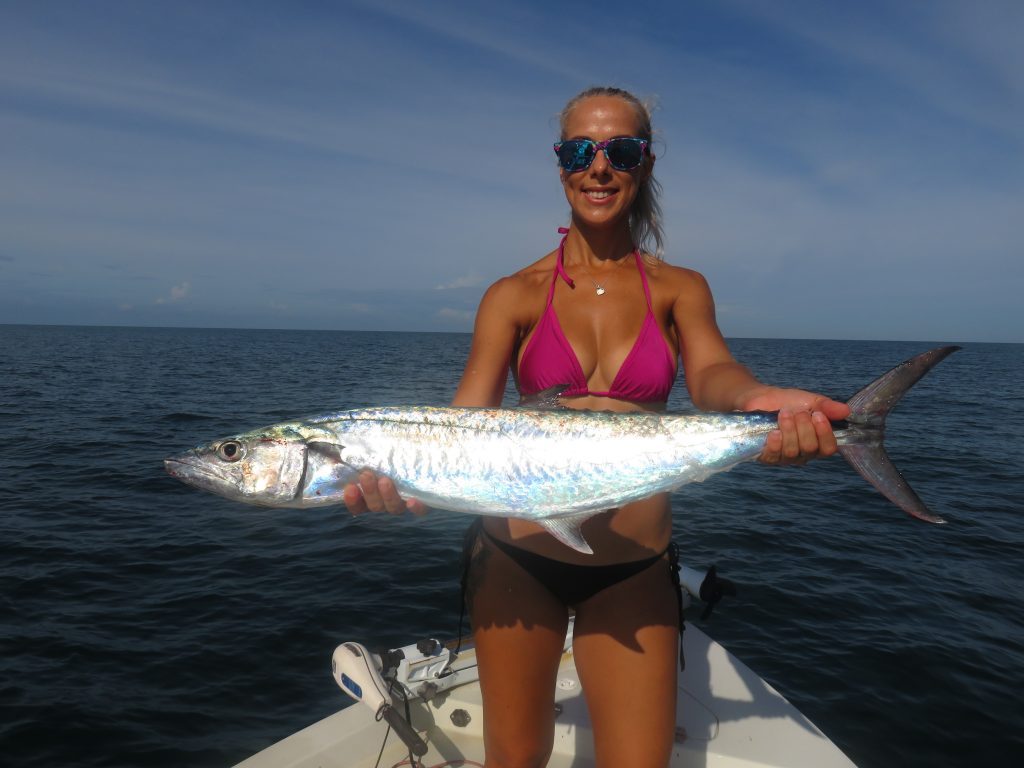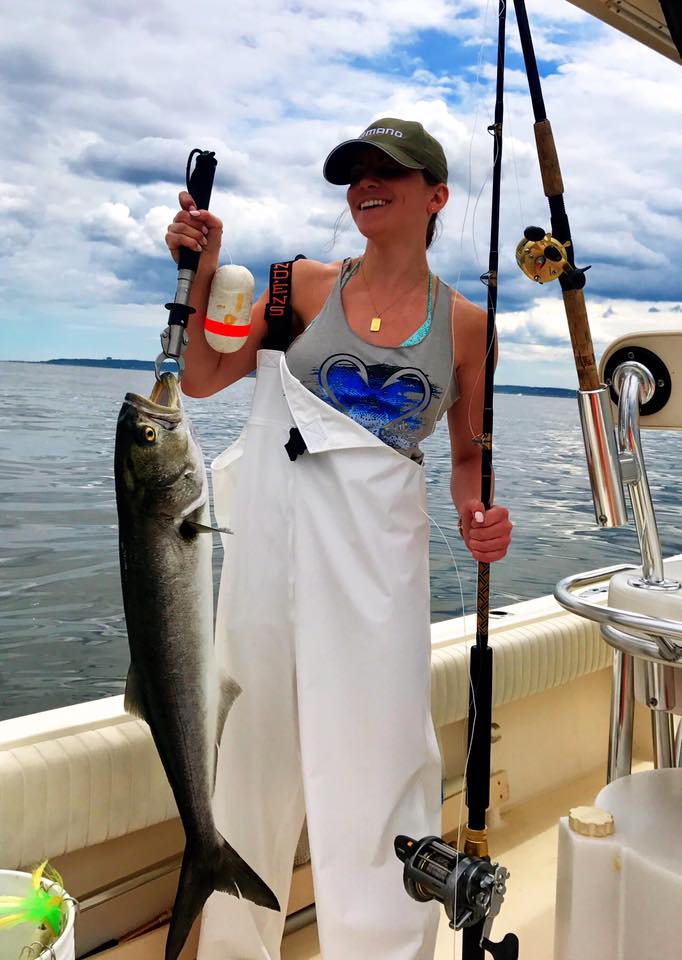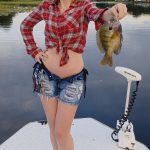Saltwater Fishing with Spoons!
In this article I will thoroughly cover saltwater fishing with spoons. A spoon is a very simple fishing lure. It consists of a curved piece of metal and a hook, and that’s about it. The shape of the spoon, both the wit and the bend, will dictate the action and also to some degree how it is used.
As a fishing guide in Sarasota, Florida, I use spoons quite often on my charters. Besides the obvious that they catch fish, spoons can be easier to use that other lures. In most instances, they are designed to imitate bait fish. The flash and vibration that a spoon emits does imitate a bait fish that is in distress.
Spoons are also versatile saltwater fishing lures. I use them in several different manners on my Sarasota fishing charters. Spoons can be cast out a long way as they are dense and relatively heavy compared to other lures. Trolling is another very effective way to present spoons to game fish. Finally, anglers can vertically jigging a spoon over structure or pods of bait fish with excellent success.
Saltwater fishing with spoons
Like everything else, spoons have advantages and disadvantages. The only real disadvantage of a spoon is that it does not imitate crustaceans such as crabs and shrimp as well as other lures. However, the advantages of a spoon often offset this. One of the best aspects about saltwater fishing with a spoon is that it does not take a great deal of experience or technique in order to work the lure properly.
As mentioned above, free techniques in which spoons can be used are casting, trolling, and vertically jigging. Each technique is a bit different and does require different tackle and techniques.
Spoons come in a variety of sizes, shapes, and colors and finishes. Here in Sarasota where I fish, the water is fairly clear and just about all of our bait fish are silvery and color. This is true for most saltwater fishing in general. For these reasons, silver is by far the number one finish used by anglers saltwater fishing with spoons. Some bright color or flash can be incorporated into a silver spoon as well. Gold is an excellent finish early and late in the day as well as when the water has a bit of color to it.
Generally speaking, the best approach is to “match the hatch” so to speak. This simply means choosing a spoon that is the general size and color of the bait fish forage that is in the area. Saltwater game fish will feed on anything from three-quarter inch long glass minnows to bunker and blue runner that are almost a foot long.
Best saltwater fishing spoons
This is my list of my favorite spoons for saltwater fishing. There are certainly many more to choose from, but these are my personal favorite spoons. Some work well for only one technique, other do all three.
-
Kastmaster spoon – casting, trolling, jigging
-
Clark trolling spoon – trolling
-
Crippled Minnow spoon casting, trolling, jigging
-
Johnson Silver Minnow spoon – casting in shallow water
-
Bunker spoon – trolling
-
Hopkins jigging spoon – jigging
Casting spoons
Spoons are outstanding casting lures! For the most part, they are heavy, dense, and fairly aerodynamic. This means that they can be cast a long way, longer than just about any other lure. This is beneficial in several ways. It allows anglers to cover more water. Long casts also are more productive on days when fish are spooky and difficult to approach. For many anglers surf fishing, spoons are the lure of choice just for this reason.
From a charter boat captains standpoint, one thing that makes spoons an excellent choice is the fact that most have pretty good built in action. This means that the client anglers only need to cast out, allow the bait to settle, then reel it back in. I often suggest that the retrieve be interrupted with a hard jerk and a pause every so often. This very realistically imitates a wounded bait fish. However, most spoons will produce on a steady retrieve.
Casting spoons are an excellent choice any time there is surface activity be seen. This includes the fish feeding on the surface, schools of bait fish or bait balls, birds diving, or any other indication that fish are feeding high up in the water column. Again, the longer casting range of spoons can be very beneficial when a school of false albacore or other game fish suddenly pop up for only a few seconds. A quick, accurate casts of a spoon to the edge of the feeding area will generally draw a strike.
Casting spoons are also outstanding search baits when fish are not seen feeding on the surface. I use them quite often when fish are scattered about in difficult to pinpoint. The best approach is to fan cast an area, covering different angles with each cast. Anglers should very the retrieve as well as the depth that which they are retrieving the spoon. Once fish are found, anglers can concentrate on that area.
For the most part, spinning tackle is the best choice when casting spoons. This is especially true for lighter spoons and a 1/4 ounce to 1 ounce size. Here in Florida where I fish, I mainly cast spoons three 1/2 ounce and ¾ ounce. For my application, a 7 foot spinning rod loaded with 10 pound line is perfect. Anglers casting heavier spoons for larger fish may need to bump up the tackle. Experienced anglers casting quite heavy spoons, and this includes those surf fishing, often opt for conventional or bait casting reels. However, for the novice or inexperienced angler, spinning tackle is the best choice.
Trolling with spoons
Trolling is an extremely effective angling technique that has been around a very long time. It basically involves driving the boat around at very slow speeds while pulling lures behind the boat. The aspect that makes it so productive is that anglers can present multiple baits at multiple depths in search of fish. While an angler can only cast and retrieve one spoon, he or she can troll as many as is practical or legally allowed.
Some spoons can be trolled without any excess gear to get them down in the water column. Is particularly true for heavier spoons as well as when the fish are feeding high in the water column. A 2 ounce to 3 ounce spoon can be trolled at a bit above idle speed and will still stay down several feet and the water column.
However, in most cases anglers will need some type of device in order to get the spoon down deeper in the water column. This is especially true when trolling for species such as king mackerel and Spanish mackerel which often hit higher speeds of 5 to 7 kn. The two most popular methods are in line trolling sinkers and planers. Many anglers will ask about downrigger’s, however they are not used as extensively by anglers saltwater fishing with spoons. The primary reason is the speed at which most anglers troll, it would result in the ball swinging up in the water column, defeating the purpose.
Trolling spoons with inline sinkers
The easiest method used by anglers to get the spoon down in the water column is simply an in line trolling sinker. This is simple and easy, though anglers will be limited to the depths that can be fished. There are several different designs, but basically it is a sinker with swivels at either end. The main line is tied to one and and then the leader is tied to the other. Within reason, the longer the leader, the more effective the spoon. 20 feet is a good all-around length.
Deploying spoons on a trolling sinker is quite easy. The boat is simply put into gear and the spoon let out behind the boat. Once a tighten up, the angler drops the sinker in the water and slowly pays the line out to the desired length. I like to use the count back method, thereby varying each spoon and avoiding tangles. Once all the rods are out and with the rods placed in holders, the boat is driven around in search of fish.
When a fish strikes, and angler grabs the rod and fights the fish back to the boat. It is important to keep the boat in gear, even it just and idle, to keep the other lines from to angling. Multiple hookups are not uncommon at all! Once the angler reels the sinker up to within a foot or so of the rod tip, the fish must be hand lined in the rest of the way.
Trolling with planers
Planers are clever devices designed to take spoons and other lures deeper into the water column. They are a tad complicated at first, but once the angler learns the intricacies of them, they become a very effective tool. The primary benefit of planers over sinkers is that with the planers the spoons do not run any shallower with an increase in speed. Therefore, anglers trolling for faster species such as mackerel, wahoo, and other game fish can troll fast and still keep the lures down to the desired depth.
The planer has a sliding ring which is the key to its effectiveness. The running line is tied to this ring. A 20 foot leader is tied to the back of the planer and then the spoon. I like to use quality snap swivel’s on both ends of the leader to help avoid twist. The planer is put into the water with the ring at the top. The planer will then dig down to the determined depth. The angler counts back the line and places the rod in the rod holder. There will be a significant bend in the rod due to the pole of the planer, until a fish strikes.
When a fish hits, it will trip the planer. The rod tip will jerk up and then bend again from the weight of the fish. If it is a large fish, the drag will start screaming! The fish is then bought in back to the boat, without having to deal with the resistance of the planer. Like with the sinker, once the planer reaches a foot or so of the rod tip, the fishes hand lined in the rest of the way.
Planers come in several sizes. A #1 planer will go down 5 to 7 feet and I like to use 30 pound fluorocarbon leader. A #2 planer will go down 12 to 15 feet and I like to use a 50 pound fluorocarbon leader. A #3 planer will go down 25 or 30 feet and I use an 80 pound fluorocarbon leader. A number three planer will put a significant strain and a stout rod is needed.
Speaking of rods, while spinning tackle is the best choice for casting, conventional tackle is far superior when trolling. Conventional reels have more line capacity, better drags in general, and offer anglers more power and better gear ratios. Most anglers saltwater fishing already have light to medium conventional outfits which are fine for trolling spoons with either planers or sinkers.
Vertical fishing with spoons
The third technique that anglers can use successfully when saltwater fishing with spoons is vertically jigging. This is used quite commonly in the Northeast for sea bass, flute, striped bass, and other species. Here in Florida we don’t use it quite as often, as many of our fish are high in the water column.
In fairly shallow water and using light spoons spinning tackle is fine. However anglers fishing with heavier spoons in deeper water and or strong current and when targeting larger fish will do better with a conventional rig. As mentioned above, these give anglers more power than spinning rods. The faster retrieve ratios also come in handy.
This type of fishing is most often done over some type of structure. The structure can be a rack, reef, ledge, or area of hard bottom. It is case the spoon is drop to the bottom reeled up a crank or so and then vigorously jigged and allowed to fall. Sometimes it is best to keep the spoon at the bottom while other times it should be worked up through the water column until a strike occurs.
Vertically jigging a spoon will also produce when large schools of bait, also known as bait balls, are located in the vicinity of game fish. The spoon is lowered down to the level of the bait and then jigged sharply and allowed to fall. This is a technique used often on party boats and is a very effective fishing technique.
In conclusion, this article on saltwater fishing with spoons will help anglers understand how to effectively use these very productive saltwater fishing lures!
















